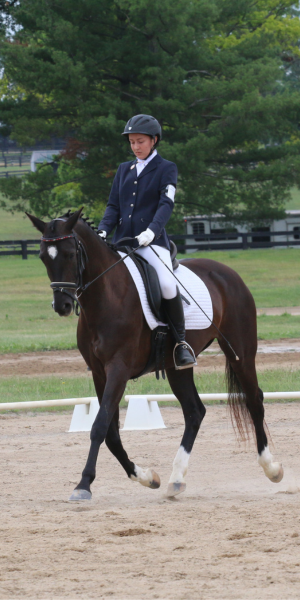
The C-3 candidate demonstrates an independent seat and progress toward an independent hand with coordinated use of aids throughout the execution of USEF First Level movements and tests. Candidates should show correct alignment, posture, and mechanics in sitting trot and canter while maintaining a steady, elastic rein contact.
The B candidate must demonstrate an independent seat and hand throughout the execution of USEF Second Level movements. The candidate should show a correct alignment, stability and elasticity in their position, be able to stay centered in lateral movements while demonstrating appropriate angle and bend. The candidate should be confident in identifying and assessing evasions/resistance on their own and on a switch mount and be able to maintain the qualities of the training scale.
The A candidate shows the ability to ride with increased engagement and clear, well-defined transitions between collected, medium, and extended gaits as required at the USEF Third Level movements. Utilizing an extensive “tool box” of schooling techniques, the candidate must accurately assess and advance the training of a wide variety of mounts at various stages of training demonstrating a confident, consistent, and effective performance on each.
Ground training is a very important part of horsemanship. Good ground training teaches obedience, respect, trust, and cooperation, and helps to establish good working relationships between trainer and horse. (USPC Manual of Horsemanship: Advanced Horsemanship)
The Training Scale has evolved as a means to illustrate the different steps that are essential elements in the correct training of the horse. It is important to understand that these elements are interrelated. One step is not supposed to be perfect before attempting the next, but instead, they should be used as a reference for understanding the general progression and development of the horse in his training from young horse to final goals. (USPC Manual of Horsemanship: Advanced Horsemanship)

This is part of the Eastern States Dressage and Combined Training Association's 2007 Symposium for Judges, Trainers and Competitors. Bronze medalist Steffen Peters and FEI-I judge Janet Brown-Foy join forces provide guidance on the correct foundation through all levels of dressage. In the first of 9 videos in this series, they provide an Overview of the training scale and the basic gait requirements, with the help of horse and rider pairs: Wyoming and Annette Longo; Arjen fan Bosksicht and Mara Tolas; Onno and Lisa Tannehill; and Lucien and Barbara Wolfe. Posted with the gracious permission of the ESDCTA.